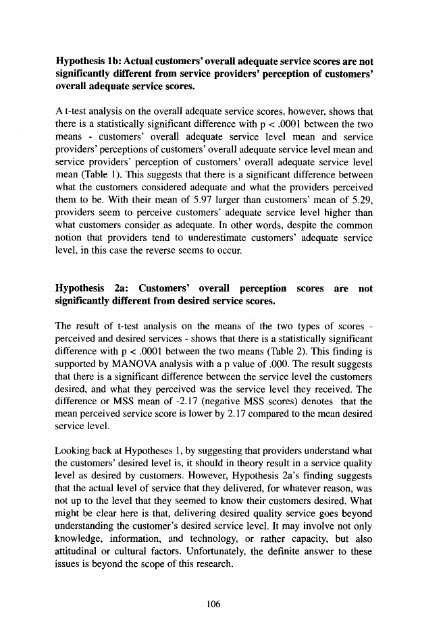(jit) principles and systematic layout planning as tools to improve ...
(jit) principles and systematic layout planning as tools to improve ...
(jit) principles and systematic layout planning as tools to improve ...
Create successful ePaper yourself
Turn your PDF publications into a flip-book with our unique Google optimized e-Paper software.
Hypothesis Ib: Actual cus<strong>to</strong>mers' overall adequate service scores are not<br />
significantly different from service providers' perception of cus<strong>to</strong>mers'<br />
overall adequate service scores.<br />
A t-test analysis on the overall adequate service scores, however, shows that<br />
there is a statistically significant difference with p < .0001 between the two<br />
means - cus<strong>to</strong>mers' overall adequate service level mean <strong>and</strong> service<br />
providers' perceptions of cus<strong>to</strong>mers' overall adequate service level mean <strong>and</strong><br />
service providers' perception of cus<strong>to</strong>mers' overall adequate service level<br />
mean (Table 1). This suggests that there is a significant difference between<br />
what the cus<strong>to</strong>mers considered adequate <strong>and</strong> what the providers perceived<br />
them <strong>to</strong> be. With their mean of 5.97 larger than cus<strong>to</strong>mers' mean of 5.29,<br />
providers seem <strong>to</strong> perceive cus<strong>to</strong>mers' adequate service level higher than<br />
what cus<strong>to</strong>mers consider <strong>as</strong> adequate. In other words, despite the common<br />
notion that providers tend <strong>to</strong> underestimate cus<strong>to</strong>mers' adequate service<br />
level, in this c<strong>as</strong>e the reverse seems <strong>to</strong> occur.<br />
Hypothesis 2a: Cus<strong>to</strong>mers' overall perception scores are not<br />
significantly different from desired service scores.<br />
The result of t-test analysis on the means of the two types of scores -<br />
perceived <strong>and</strong> desired services - shows that there is a statistically significant<br />
difference with p < .0001 between the two means (Table 2). This finding is<br />
supported by MANOVA analysis with a p value of .000. The result suggests<br />
that there is a significant difference between the service level the cus<strong>to</strong>mers<br />
desired, <strong>and</strong> what they perceived w<strong>as</strong> the service level they received. The<br />
difference or MSS mean of -2.17 (negative MSS scores) denotes that the<br />
mean perceived service score is lower by 2.17 compared <strong>to</strong> the mean desired<br />
service level.<br />
Looking back at Hypotheses 1, by suggesting that providers underst<strong>and</strong> what<br />
the cus<strong>to</strong>mers' desired level is, it should in theory result in a service quality<br />
level <strong>as</strong> desired by cus<strong>to</strong>mers. However, Hypothesis 2a's finding suggests<br />
that the actual level of service that they delivered, for whatever re<strong>as</strong>on, w<strong>as</strong><br />
not up <strong>to</strong> the level that they seemed <strong>to</strong> know their cus<strong>to</strong>mers desired. What<br />
might be clear here is that, delivering desired quality service goes beyond<br />
underst<strong>and</strong>ing the cus<strong>to</strong>mer's desired service level. It may involve not only<br />
knowledge, information, <strong>and</strong> technology, or rather capacity, but also<br />
attitudinal or cultural fac<strong>to</strong>rs. Unfortunately, the definite answer <strong>to</strong> these<br />
issues is beyond the scope of this research.<br />
106


